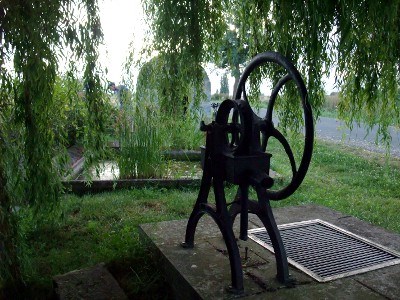
Montfort est un nom latin « Mons fortis » très répandu en France. Il indique une élévation fortifiée, en général par les Romains, donc entre le premier et le 4è siècle de notre ère. Le Mont Fort s’élevait de l’autre côté de la route Saumur/Doué, vers Piémont. Il y existe des vestiges de pierres de construction.
Le Village où nous sommes ne s’appelait pas MONTFORT avant le XVIe siècle, il s’appelait «Villa Spinacium» ou «Villa d’Epina» en raison de l’épine noire qui y poussait. A partir du XVème siècle les habitants de MONTFORT descendirent à EPINA, le «colonisèrent» - en partie sans doute - puisqu’ils apportèrent aussi le nom de leur village à EPINA qui se nomme au XVIIIe siècle, MONTFORT allias EPINA. Seul le château a gardé le nom d’EPINA. Ce terrain est un calcaire de tuffeau, appartenant à l’ère secondaire, appelé le TURONIEN (de la ville de TOURS située à 70 Km à l’est de Saumur). Ce tuffeau, du crétacé, voisine ici le terrain tertiaire du miocène (à un kilomètre dans la plaine) et qui a laissé les faluns. Ces deux terrains ont 40 millions d’années de différence. On trouve les deux pierres mélangées dans les constructions de la région :
- le tuffeau, pierre blanche du crétacé
- le falun, plus ocre, appelé aussi grison parce qu’il devient gris en vieillissant
Texte recopié avec l'aimable autorisation de l'office de tourisme de Doué-la-Fontaine et sa région.
--[English]--
Montfort is a latin word « Mons fortis » well spread in Europe. It indicates a fortified elevation, mainly by the Roman people, between the 1st and the 4th century of our era. The strong mount (Mont Fort) was rising the other side of the road Saumur/Doué, towards Piémont. There remains construction stones.
The village where we are was not called Montfort before the 16th century, it was called «Villa Spinacium» or «Villa d’Epina» because of the black thorn that grew there. Starting 15th century, inhabitants of Montfort went to Epina, «colonized» it - maybe partly - as they also brought their village name to Epina, which is named, at the 17th century, Montfort allias Epina. Only the castle kept the name of Epina. This terrain is a limestone of freestone, belonging to the Secondary era, called Turonian (from the city of Tours located 70 km [44 miles] east of Saumur). This freestone, from cretaceous, is next to Tertiary terrain of Miocene (one kilometer in plains) and which has left the shelly sands. These two terrains have 40 million years difference. We find the two stones mixed in the area buildings :
- the freestone, white stone of cretaceous
- the shelly sand, ocher, also called «grison» because it becomes gray when aging
Text translated by myself from above, sorry for any mistake it may contain.